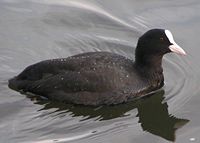Coot
| Coots | ||||||||||||
|---|---|---|---|---|---|---|---|---|---|---|---|---|
 Eurasian coot or common coot
| ||||||||||||
| Scientific classification | ||||||||||||
| ||||||||||||
For prehistoric species, see article text |
Coot is the common name for any of the medium-sized, duck-like aquatic birds comprising the genus Fulica of the rail family Rallidae, characterized by a dark head with a short beak that extends to the forehead as a prominent, flattened, fleshy frontal shield or other decoration on the forehead, and toes that are lobed with a membrane. Coots have predominantly black plumage, and, unlike many of the rails, they are usually easy to see, often swimming in open water. They are close relatives of the moorhen.
Overview and description
The greatest species variety is in South America, and it is likely that the genus originated there. They are common in Europe and North America.[citation needed]
They have prominent frontal shields or other decoration on the forehead, and coloured bills, and many, but not all, have white on the under tail. Like other rails, they have lobed toes.
They tend to have short, rounded wings and are weak fliers, although northern species are nevertheless capable of covering long distances; the American Coot has reached Great Britain and Ireland on rare occasions. Those species that migrate do so at night.
Coots can walk and run vigorously on strong legs, and have long toes that are well adapted to soft, uneven surfaces.
These birds are omnivorous, taking mainly plant material, but also small animals and eggs. They are aggressively territorial during the breeding season, but are otherwise often found in sizeable flocks on the shallow vegetated lakes they prefer. A flock of coots is known in the US as a cover.[1]
Species in taxonomic order
- Red-knobbed Coot, Fulica cristata
- Eurasian Coot, or Common Coot, Fulica atra
- Hawaiian Coot, Fulica alai
- American Coot, Fulica americana
- Caribbean Coot, Fulica caribaea
- White-winged Coot, Fulica leucoptera
- Andean Coot, Fulica ardesiaca
- Red-gartered Coot, Fulica armillata
- Red-fronted Coot, Fulica rufifrons
- Giant Coot, Fulica gigantea
- Horned Coot, Fulica cornuta
- Mascarene Coot, Fulica newtoni (extinct, c.1700)
- Chatham Island Coot, Fulica chathamensis (prehistoric)
- New Zealand Coot, Fulica prisca (prehistoric)
- Fulica infelix (fossil: Early Pliocene of Juntura, Malheur County, Oregon, USA)
- Fulica shufeldti (fossil: Pleistocene of North America) - possibly a subspecies of Fulica americana; formerly F. minor
Photo gallery
A female Eurasian coot leads her two young to the pond: WWT Barnes London
- Eurocoot.JPG
A European coot swims along.
ReferencesISBN links support NWE through referral fees
Bridgman, A. 2003. "Fulica americana" (On-line), Animal Diversity Web. Accessed January 22, 2009 at http://animaldiversity.ummz.umich.edu/site/accounts/information/Fulica_americana.html.
- Integrated Taxonomic Information System (ITIS). 2006. Fulica Linnaeus, 1758 ITIS Taxonomic Serial No.: 176289. Retrieved January 23, 2009.
- Rails by Taylor and van Perlo, ISBN 90-74345-20-4
External links
- Coot videos on the Internet Bird Collection
- Coot Photos Wildlife Coot pictures and voice
Credits
New World Encyclopedia writers and editors rewrote and completed the Wikipedia article in accordance with New World Encyclopedia standards. This article abides by terms of the Creative Commons CC-by-sa 3.0 License (CC-by-sa), which may be used and disseminated with proper attribution. Credit is due under the terms of this license that can reference both the New World Encyclopedia contributors and the selfless volunteer contributors of the Wikimedia Foundation. To cite this article click here for a list of acceptable citing formats.The history of earlier contributions by wikipedians is accessible to researchers here:
The history of this article since it was imported to New World Encyclopedia:
Note: Some restrictions may apply to use of individual images which are separately licensed.
- ↑ Baltimore Bird Club. Group Name for Birds: A Partial List. Retrieved 2007-06-03.




